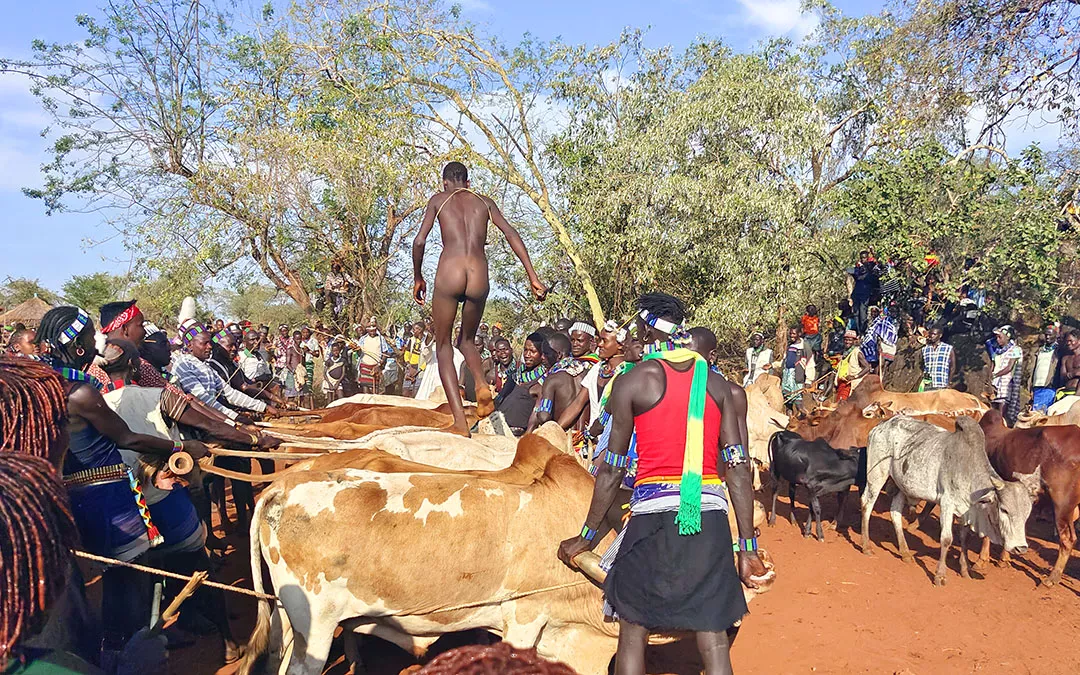The Hamar tribe is one of the most fascinating ethnic groups in Ethiopia. They live in the southwestern part of the country, in the Omo River valley. The Hamar are known for their unique rituals, their vibrant beadwork and body painting, and their strong sense of community.
One of the most important rituals for the Hamar is the bull jumping ceremony. This is a rite of passage for young men, who must successfully run across the backs of a row of bulls in order to prove their manhood. The bull jumping ceremony is a symbol of strength, courage, and resilience, and it is an important part of Hamar culture.
The Hamar are also known for their beautiful beadwork. Women in the tribe wear elaborate necklaces, bracelets, and headdresses made of beads. The beads are often brightly colored and patterned, and they are a symbol of the Hamar’s creativity and artistic talent.
Body painting is another important part of Hamar culture. Men and women in the tribe paint their bodies with intricate designs using natural pigments. The body paintings are often symbolic, and they can represent the Hamar’s beliefs, values, or social status.
The Hamar are a strong and resilient people. They have faced many challenges over the years, including drought, famine, and conflict. However, they have always managed to preserve their culture and way of life. The Hamar are an inspiration to us all, and they remind us of the importance of tradition and community.
Here are some frequently asked questions about the Hamar tribe:
- What is the Hamar tribe known for?
- The Hamar tribe is known for its unique rituals, like the bull jumping ceremony and the night dance, Evangadi. They are also recognized for their distinctive hairstyles, body paintings, and beadwork.
- Where does the Hamar tribe live?
- The Hamar tribe primarily resides in the Southwestern part of Ethiopia, specifically in the Omo River valley, an area known for its rich biodiversity and diverse ethno-linguistic groups.
- What language does the Hamar tribe speak?
- The Hamar tribe speaks a language known as Banna – Hamar, which belongs to the Omotic family of languages native to Southwestern Ethiopia.
- How does the Hamar tribe’s economy work?
- The Hamar tribe’s economy is a blend of subsistence farming, cattle rearing, and trade. Farming and cattle herding form the backbone of their economy, while local marketplaces serve as hubs for trade and social interaction.
- What challenges does the Hamar tribe face?
- The Hamar tribe faces several challenges, including preserving their cultural traditions amidst the pressures of modernization and globalization, managing the impact of tourism, and accessing essential services like healthcare and education.
- How is the Hamar tribe’s social structure organized?
- The Hamar tribe’s social structure is complex, with roles and statuses often determined by age, gender, marital status, and wealth. Women play crucial roles in household management and rituals, while men are primarily responsible for cattle herding, defense, and decision-making.
- ConclusionUnraveling the intricate cultural tapestry of the Ethiopian Ethnical Group Hamar Tribe offers valuable insights into a unique way of life deeply rooted in tradition, social relationships, and the natural environment. As they navigate the currents of change, their resilience and cultural richness stand as a testament to their unique heritage. While challenges lie ahead, the Hamar tribe’s journey towards the future promises to be as fascinating as their past.

